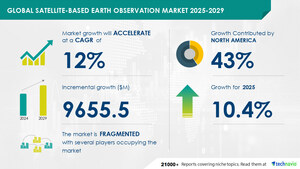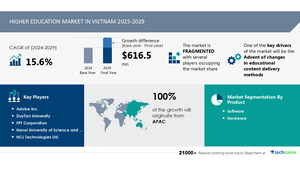NEW YORK, July 31, 2024 /PRNewswire/ -- The global diagnostic imaging market size is estimated to grow by USD 8.69 billion from 2023-2027, according to Technavio. The market is estimated to grow at a CAGR of almost 5.93% during the forecast period. Increasing prevalence of chronic conditions is driving market growth, with a trend towards integration of ai with diagnostic imaging. However, high costs associated with diagnostic imaging poses a challenge. Key market players include Agfa Gevaert NV, Allengers Medical Systems Ltd., BCL XRay Canada Inc., Carestream Health Inc., CurveBeam AI Ltd., Esaote Spa, Fujifilm Corp., General Electric Co., Hitachi Ltd., Hologic Inc., Konica Minolta Inc., Mediso Ltd., Neusoft Corp., Northrop Grumman Corp., Planmeca Oy, Shenzhen Mindray BioMedical Electronics, Shimadzu Corp., Siemens AG, SternMed GmbH, and Thales Group.
Get a detailed analysis on regions, market segments, customer landscape, and companies - Click for the snapshot of this report
Forecast period |
2023-2027 |
Base Year |
2022 |
Historic Data |
2017 - 2021 |
Segment Covered |
Product (X-ray, Ultrasound, Magnetic resonance imaging, Computed tomography, and Others), End-user (Hospitals and clinics, Diagnostic centers, Research laboratories and institutes, and Others), and Geography (North America, Europe, Asia, and Rest of World (ROW)) |
Region Covered |
North America, Europe, Asia, and Rest of World (ROW) |
Key companies profiled |
Agfa Gevaert NV, Allengers Medical Systems Ltd., BCL XRay Canada Inc., Carestream Health Inc., CurveBeam AI Ltd., Esaote Spa, Fujifilm Corp., General Electric Co., Hitachi Ltd., Hologic Inc., Konica Minolta Inc., Mediso Ltd., Neusoft Corp., Northrop Grumman Corp., Planmeca Oy, Shenzhen Mindray BioMedical Electronics, Shimadzu Corp., Siemens AG, SternMed GmbH, and Thales Group |
Key Market Trends Fueling Growth
The diagnostic imaging market is experiencing significant growth due to the integration of artificial intelligence (AI). This technology automates and standardizes complex diagnostic procedures, enhances equipment features, and improves patient outcomes while reducing costs. AI techniques, such as object detection and image segmentation, enable faster and more accurate identification of relevant patterns. Leading healthcare companies like Siemens Healthineers and GE Healthcare are collaborating with tech firms to incorporate AI into their imaging equipment. For instance, Siemens Healthineers and Intel Corp. Are working together on AI-based cardiac MRI for real-time diagnosis of cardiovascular diseases. Startups like NANOX IMAGING are also entering the market, receiving FDA clearance for their AI-enabled digital X-ray system. These investments and collaborations will drive the growth of the diagnostic imaging market by improving imaging quality and increasing adoption of AI technology.
The Diagnostic Imaging Market is experiencing significant trends in various segments. Age-related macular degeneration and chronic diseases like cardiovascular disorders and neurology disorders are driving the demand for advanced imaging technologies. Computer vision and AI-enabled diagnostic equipment from companies like Google Cloud and Siemens Healthineers are becoming popular. The Economic setback has led to an increase in demand for teleradiology services and refurbished equipment in the market. The Computed Tomography market, including CT scanners from Siemens Healthineers, leads the pack. Ultrasound segment, with portable devices and advanced transducers, is also growing. Hospitals and teaching hospitals are major consumers. Government initiatives like India's X-Ray Setu and AI platforms from Google's Deepmind and Moorfields Eye Hospital are revolutionizing early detection tools and turnaround time. Molecular imaging and orthopedic disorders are other emerging areas. Market leaders like Siemens Healthineers are expanding their cardiovascular ultrasound portfolio with offerings like Affiniti CVx. Overall, the market is competitive, with state-of-the-art imaging modalities like X-ray, MRI, CT, and ultrasound continuing to dominate. Product recalls and safety concerns are challenges.
Discover 360° analysis of this market. For complete information, schedule your consultation- Book Here!
Market Challenges
- Diagnostic imaging is an essential component of healthcare, particularly in fields such as oncology, cardiology, and gynecology. However, the high costs associated with diagnostic imaging equipment and procedures are a significant barrier to market growth. For instance, an MRI machine costs between USD150,000 and USD300,000, and additional costs are incurred for installation, remodeling, and annual service maintenance. The cost of annual service maintenance includes preventative maintenance, parts, labor charges, and technician allowances, which can amount to USD95,000-USD120,000 for a PET/CT scanner and USD100,000-USD140,000 for a CT system tube replacement. The cost of diagnostic imaging procedures also varies, with an MRI procedure costing between USD200 and USD2,200, a CT scan between USD50 and USD1,500, and an X-ray between USD50 and USD450. These costs cover hospital facilities, physician fees, and support staff fees. The cost of diagnosis can also depend on the healthcare infrastructure, potentially discouraging people from seeking necessary imaging in developing countries. Overall, the high costs of diagnostic imaging equipment and procedures can limit market growth.
- The Diagnostic Imaging Market faces several challenges in 2023. Aging populations and chronic diseases like age-related macular degeneration drive demand for advanced imaging technologies. However, economic setbacks and product recalls can impact market growth. Teleradiology services and AI-enabled diagnostic equipment from companies like Google Cloud and Siemens Healthineers are transforming the industry. The Computed Tomography market, including CT scanners and advanced transducers, dominates, but Ultrasound, including portable devices, also gains popularity. Hospitals, teaching hospitals, and surgical suites in developed regions require state-of-the-art imaging modalities like MRI, CT, X-ray, and molecular imaging for cardiovascular disorders, neurology disorders, orthopedic disorders, and early detection tools. Government initiatives like India's X-Ray Setu and AI platforms from companies like Google's Deepmind and Moorfields Eye Hospital are shaping the future of diagnostics. However, challenges remain, including turnaround time, product recalls, and the refurbished equipment market. Companies like Siemens Healthineers, with market-leading positions and cardiovascular ultrasound portfolios like the Affiniti CVx, are addressing these challenges and driving innovation in radiology operations.
For more insights on driver and challenges - Download a Sample Report
Segment Overview
This diagnostic imaging market report extensively covers market segmentation by
- Product
- 1.1 X-ray
- 1.2 Ultrasound
- 1.3 Magnetic resonance imaging
- 1.4 Computed tomography
- 1.5 Others
- End-user
- 2.1 Hospitals and clinics
- 2.2 Diagnostic centers
- 2.3 Research laboratories and institutes
- 2.4 Others
- Geography
- 3.1 North America
- 3.2 Europe
- 3.3 Asia
- 3.4 Rest of World (ROW)
1.1 X-ray- The global digital X-ray systems market is experiencing robust growth, with the digital X-ray segment leading the charge. This growth is driven by the increasing adoption of digital radiography (DR) systems in developed regions, particularly North America and Europe. The shift to digital X-ray systems is due to their numerous advantages, such as improved image quality, faster processing times, and lower radiation doses. In contrast, conventional X-ray systems have larger image receptors, moderate resolution, and longer processing times, and their use is associated with higher radiation doses. According to the World Health Organization, breast cancer was the most common cancer in 2020, with 2.3 million diagnoses and 685,000 deaths worldwide. Digital X-ray systems' ability to detect abnormalities more effectively, particularly in low-contrast environments, makes them increasingly essential for diagnosing chronic diseases like breast cancer and spinal disorders. Despite the benefits, the digital X-ray systems market faces regulatory challenges. In the US, all X-ray equipment is classified as Class III medical devices, requiring extensive regulatory processes to ensure safety and efficacy. The US Food and Drug Administration (FDA) prevents unsafe and ineffective devices from entering the market, which may negatively impact sales and profit margins for manufacturers. However, technological advances and the growing adoption of portable and mobile digital X-ray systems are expected to drive market growth. New generation mobile X-ray units offer increased efficiency and cost savings compared to standalone systems. Wireless mobile X-ray systems provide flexibility in healthcare facilities by enabling the sharing of medical images between mobile and fixed systems. Vendors are investing in innovative mobile and portable digital X-ray systems to enhance market growth. For instance, Nanox recently received FDA approval for its NANO-X IMAGING's single-source Nanox.ARC Digital X-ray technology, which has the potential to lower diagnostic imaging system costs and deliver early detection services effectively. These factors are expected to fuel market growth during the forecast period.
For more information on market segmentation with geographical analysis including forecast (2023-2027) and historic data (2017 - 2021) - Download a Sample Report
Research Analysis
The Diagnostic Imaging Market is witnessing significant growth due to the increasing demand for early detection tools in various diseases. The turnaround time for diagnostic imaging is a crucial factor driving market growth, with governments and private players investing in initiatives like India's X-Ray Setu to improve access and efficiency. Advanced state-of-the-art imaging modalities, such as cardiovascular ultrasound, are leading the market, with companies like Siemens Healthineers holding a strong market position. Artificial intelligence (AI) platforms, like those developed by Google's Deepmind and Moorfields Eye Hospital, are revolutionizing radiology operations by improving accuracy and efficiency. The economic setback caused by the pandemic has led to an increased focus on teleradiology services and the Computed Tomography market. The Ultrasound segment, with its advanced ultrasound transducers, is also experiencing growth due to its non-invasive nature and cost-effectiveness. Age-related macular degeneration, computer vision, and optical CT scanners are some of the key applications driving the market.
Market Research Overview
Diagnostic imaging market is witnessing significant growth due to the increasing demand for early detection tools for various chronic diseases such as cardiovascular disorders and neurology disorders. The market is driven by advancements in state-of-the-art imaging modalities like MRI, CT, X-ray, and ultrasound. The turnaround time for diagnostic imaging is a critical factor, and companies are investing in AI platforms to enhance efficiency. The Indian government's initiative, X-Ray Setu, aims to provide affordable diagnostic services using AI-enabled imaging technologies. Siemens Healthineers holds a strong market position with a comprehensive cardiovascular ultrasound portfolio, including Affiniti CVx. Radiology operations are being revolutionized with the integration of AI in imaging equipment from companies like Google's Deepmind and Moorfields Eye Hospital. The development of an optical CT scanner for age-related macular degeneration is a significant breakthrough in ophthalmology. The economic setback caused by the pandemic has led to an increase in demand for teleradiology services and refurbished equipment in developing regions. The Computed Tomography market is expected to grow due to the rising prevalence of chronic diseases, while the Ultrasound segment benefits from portable ultrasound devices. Advanced ultrasound transducers and surgical suits are essential accessories for hospitals. Developed regions are investing in AI-enabled diagnostic equipment, while teaching hospitals focus on molecular imaging for research and development. Product recalls and regulatory issues are challenges for the market.
Table of Contents:
1 Executive Summary
2 Market Landscape
3 Market Sizing
4 Historic Market Size
5 Five Forces Analysis
6 Market Segmentation
- Product
- X-ray
- Ultrasound
- Magnetic Resonance Imaging
- Computed Tomography
- Others
- End-user
- Hospitals And Clinics
- Diagnostic Centers
- Research Laboratories And Institutes
- Others
- Geography
- North America
- Europe
- Asia
- Rest Of World (ROW)
7 Customer Landscape
8 Geographic Landscape
9 Drivers, Challenges, and Trends
10 Company Landscape
11 Company Analysis
12 Appendix
About Technavio
Technavio is a leading global technology research and advisory company. Their research and analysis focuses on emerging market trends and provides actionable insights to help businesses identify market opportunities and develop effective strategies to optimize their market positions.
With over 500 specialized analysts, Technavio's report library consists of more than 17,000 reports and counting, covering 800 technologies, spanning across 50 countries. Their client base consists of enterprises of all sizes, including more than 100 Fortune 500 companies. This growing client base relies on Technavio's comprehensive coverage, extensive research, and actionable market insights to identify opportunities in existing and potential markets and assess their competitive positions within changing market scenarios.
Contacts
Technavio Research
Jesse Maida
Media & Marketing Executive
US: +1 844 364 1100
UK: +44 203 893 3200
Email: [email protected]
Website: www.technavio.com/
SOURCE Technavio

WANT YOUR COMPANY'S NEWS FEATURED ON PRNEWSWIRE.COM?
Newsrooms &
Influencers
Digital Media
Outlets
Journalists
Opted In





Share this article